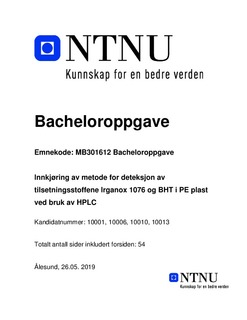| dc.contributor.advisor | Kvangarsnes, Kristine | |
| dc.contributor.author | Herigstad, Marie Leangen | |
| dc.contributor.author | Olsen, Henriette Sætre | |
| dc.contributor.author | Skjønsby, Marthe | |
| dc.contributor.author | Ørstenvik, Hanne Lillerovde | |
| dc.date.accessioned | 2019-08-25T14:01:13Z | |
| dc.date.available | 2019-08-25T14:01:13Z | |
| dc.date.issued | 2019 | |
| dc.identifier.uri | http://hdl.handle.net/11250/2610745 | |
| dc.description.abstract | Plast er en av de mest allsidige materialgruppene som noensinne er produsert, og har stor variasjon i både fysisk utforming og kjemisk funksjon. I dag produseres det store mengder plast som skaper problemer for miljøet, da ikke alt plastavfall resirkuleres. Det er derfor lagt stort fokus på å motvirke denne utviklingen. En mulig løsning kan være den plastspisende larven, Galleria mellonella, som kan bryte ned polymerstrukturen i PE plast. Under produksjon av plast tilsettes antioksidanter som gjør plasten mer slitesterk. Når plast brytes ned, kan antioksidantene forbrukes. Konsentrasjonen av antioksidanter i Galleria mellonella kan fortelle noe om nedbrytingen av plast i larven. I dette arbeidet ble det innarbeidet en metode for å måle antioksidantene BHT og Irganox 1076, ved bruk av HPLC. Instrumentet ble benyttet på bakgrunn av dets evne til å separere og detektere analytter. Analysemetoden ble validert, og ga akseptable resultater om metodens linearitet, LOD, LOQ, selektivitet, presisjon og stabilitet.
Med utgangspunkt i en tidligere studie, ble det innarbeidet en metode for ekstraksjon fra PE plast for å identifisere analyttene. En ekstraksjonsmetode av antioksidanter fra plast ble også innarbeidet. Resultatene viste at 6 timers ekstraksjon i romtemperatur ga de beste resultatene. I plast ble Irganox 1076 målt til akseptable verdier, mens det ble målt betydelig lavere konsentrasjoner av BHT. Det ble konkludert med at metodens evne til å detektere analytter var tilfredsstillende. | |
| dc.description.abstract | Plastic is one of the most versatile materials produced and has a huge variety in physical composition and chemical function. Today, plastic is produced in large quantities and creates challenges for the environment. It is therefore important to counteract this development. A potential solution is the plastic-eating larvae, Galleria mellonella, which can break down the polymer structure in PE plastic. During the production of plastic, antioxidants is added to make the material more durable. Antioxidants can be depleted when the plastic is being degraded. Therefore, the concentration of antioxidants in the larvae may indicate how much of the plastic degrades. In this experiment, it was developed a method to measure the antioxidants BHT and Irganox 1076, by HPLC. The analytical method was validated and gave acceptable results regarding the linearity, LOD, LOQ, selectivity, precision and stability.
A method for extraction of antioxidants from PE plastic was also incorporated. Extraction for 6 hours at room temperature gave the best results. Irganox 1076 was measured to quantifiable values in plastic, unlike the concentration for BHT which was below the limit of quantification and detection. In conclusion, it is clear that the method was suitable for detecting analytes. | |
| dc.language | nob | |
| dc.publisher | NTNU | |
| dc.title | Innkjøring av metode for deteksjon av tilsetningsstoffene Irganox 1076 og BHT i PE plast ved bruk av HPLC | |
| dc.type | Bachelor thesis | |
